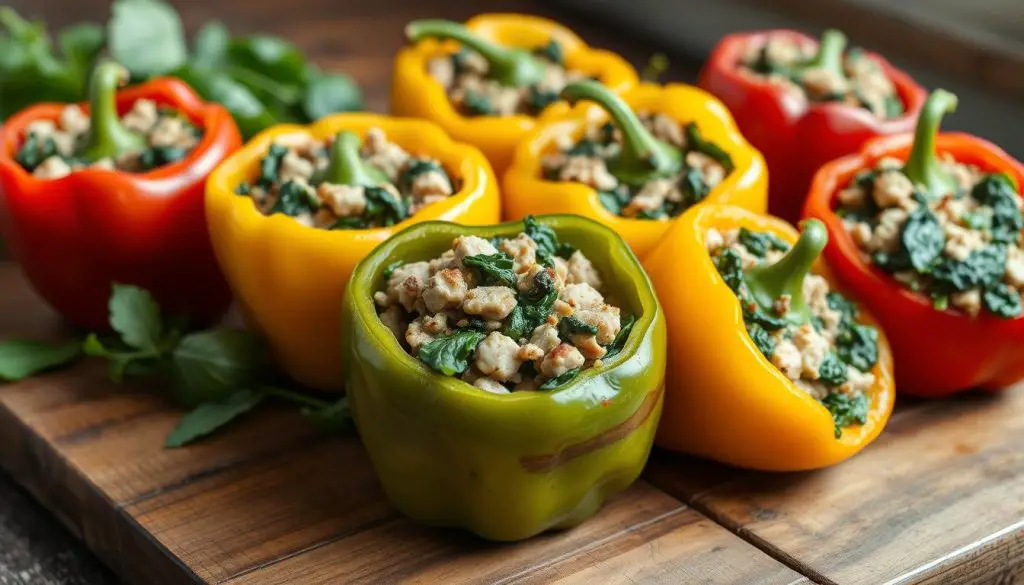Do you live with widespread pain, fatigue, and other symptoms of fibromyalgia? You’re not alone. This chronic condition affects 6 percent of women, as shown by the 2003 Canadian Community Health Survey (CCHS). But, the right diet might help ease your symptoms and enhance your life quality.
Meet our tasty “Spinach and Turkey-Stuffed Bell Peppers” recipe, made for fibromyalgia patients. It’s packed with nutrients and fiber, fighting inflammation. A study in the Scandinavian Journal of Rheumatology found that a vegan diet reduced pain by 30 percent in just three months. A single recipe could change your life.
Explore how this easy yet delicious dish can transform your fibromyalgia journey. Enjoy the benefits of anti-inflammatory, nutrient-rich ingredients that may ease your symptoms and boost your health.
What is Fibromyalgia?
Fibromyalgia is a complex and debilitating chronic musculoskeletal and neurological disorder. It affects millions of people, mostly women. This condition is marked by widespread pain, fatigue, sleep issues, and cognitive problems. It’s one of the most common rheumatic illnesses, with about 6% of women affected.
Understanding fibromyalgia is key to finding effective ways to manage it. This includes looking into dietary changes. Fibromyalgia can greatly reduce a person’s quality of life. So, it’s important to explore different ways to ease its symptoms.
Fibromyalgia is a chronic musculoskeletal and neurological disorder characterized by widespread pain, fatigue, and other symptoms.
It mainly affects women and is a common rheumatic illness. People with fibromyalgia face many tough symptoms. These include:
- Widespread chronic pain
- Extreme fatigue
- Sleep disturbances
- Cognitive difficulties (often referred to as “fibro fog”)
- Mood disorders, such as depression and anxiety
Understanding the complex nature of fibromyalgia is the first step. It helps in creating a detailed management plan. This plan addresses the many aspects of this condition.
Dietary Interventions for Fibromyalgia
Managing fibromyalgia symptoms is tough, but diet changes can help. Research shows that different diets like gluten-free, low-FODMAP, and vegan can ease pain and fatigue.
Vegetarian and Vegan Diets for Fibromyalgia
Vegetarian and vegan diets are showing great promise. A study in the Scandinavian Journal of Rheumatology found a 30% drop in pain points for those on a vegan diet. They also needed much less pain medication.
Anti-Inflammatory Diets for Fibromyalgia
Anti-inflammatory diets are also beneficial. They include foods with antioxidants and healthy fats. These diets may lower inflammation and help with symptoms.
It seems that a diet tailored to your needs can help manage fibromyalgia. Looking into diets rich in nutrients and anti-inflammatory foods could improve life for those with this condition.
Benefits of Nutrient-Dense Meals
Choosing nutrient-dense foods can greatly help those with fibromyalgia. Eating more fruits, vegetables, and foods rich in can fight chronic inflammation. These foods are full of nutrients that may ease fibromyalgia’s painful symptoms like pain, tiredness, and brain fog.
Reduce Inflammation and Alleviate Symptoms
The anti-inflammatory effects of nutrient-dense meals are key in fighting fibromyalgia. Adding more anti-inflammatory foods and antioxidant-rich items to your meals can lessen pain and muscle aches. This can also reduce other symptoms of fibromyalgia.
Leafy greens, berries, citrus fruits, fatty fish, and turmeric are great for fibromyalgia sufferers. They’re loaded with antioxidants, vitamins, and minerals. These nutrients support healing and lower inflammation.
By eating more nutrient-dense meals, you’re taking a big step towards better managing fibromyalgia. This can greatly improve your life quality.
Spinach and Turkey-Stuffed Peppers for Fibromyalgia
Living with fibromyalgia can make finding good food tough. This spinach and turkey-stuffed bell peppers recipe is a great find. It’s tasty and packed with nutrients that might help manage symptoms.
Nutrient-Dense and Fiber-Rich Ingredients
This recipe mixes lean turkey, spinach, and bell peppers for a balanced meal. Spinach is full of vitamins and minerals like vitamins A, C, and K, as well as magnesium, iron, and folate. Turkey is a lean protein source, important for fixing tissues and muscles.
Bell peppers add color and are full of antioxidants and fiber. They help keep you healthy.
Anti-Inflammatory Benefits
Fibromyalgia often leads to chronic inflammation, making symptoms worse. The ingredients in this recipe have anti-inflammatory properties. Spinach, for example, has compounds like carotenoids and flavonoids that fight inflammation.
Turkey is low in fats that can cause inflammation. This makes it a good choice for those with fibromyalgia.
Adding this recipe to your diet can help with symptom relief and overall health. Enjoy the taste and the health perks of this spinach and turkey-stuffed pepper dish.

Recipe Ingredients
To make the spinach and turkey-stuffed bell peppers, you need a mix of healthy ingredients. These ingredients are good for your body and help with fibromyalgia symptoms. They are packed with nutrients to support your health.
The main ingredients include:
- Ground turkey (1 lb) – a lean protein source that is easy to digest and rich in essential amino acids.
- Bell peppers (6 medium to large-sized) – packed with vitamins, minerals, and antioxidants to support overall health.
- No-sugar-added pasta sauce (25.5 ounces) – a flavorful, low-sugar base that provides a range of beneficial plant compounds.
- Onion (1/2 medium, diced) – offers anti-inflammatory properties and adds depth of flavor.
- Mushrooms (4 medium-sized, cut into small pieces) – a nutrient-dense ingredient that can help reduce inflammation.
- Power greens or spinach (1 cup frozen or fresh) – a leafy green that is rich in vitamins, minerals, and antioxidants.
- Zucchini squash (1/2 large or 1 small, grated) – provides fiber and essential nutrients while adding moisture to the filling.
- Organic grass-fed mozzarella (8 oz block) – a high-quality cheese that can be enjoyed in moderation as part of a fibromyalgia-friendly diet.
- Organic tomato paste (3 ounces) – a concentrated source of lycopene, an important antioxidant.
- Parmesan cheese (1 tablespoon, grated) – a flavorful addition that can be adjusted to personal preferences.
- Italian seasoning (3-1/2 teaspoons) – a blend of herbs that adds depth of flavor without increasing inflammation.
- Garlic (2 teaspoons, minced) – a potent anti-inflammatory ingredient that enhances the overall taste.
- Ground black pepper (1 teaspoon) – a spice that can help reduce inflammation and improve digestion.
- Red chili flakes (1/2 teaspoon) – an optional ingredient that can add a gentle heat and further anti-inflammatory benefits.
- Himalayan pink salt (1/2 teaspoon) – a naturally occurring salt that is rich in minerals and can be enjoyed in moderation.
- Nutritional yeast (1 teaspoon, optional) – a vegan-friendly ingredient that provides a savory, cheese-like flavor.
- Erythritol (1 teaspoon, optional) – a natural sweetener that can be used to adjust the flavor profile if desired.
These ingredients work together to make a meal that is good for your body. It’s packed with nutrients to help with fibromyalgia symptoms.
Preparation Method
Making the tasty spinach and turkey-stuffed bell peppers is easy. It fits well into a fibromyalgia-friendly meal plan. Just follow these simple steps to make this fibromyalgia-friendly meal:
- Preheat your oven to 375°F (190°C).
- Wash and slice the bell peppers in half lengthwise, removing the seeds and membranes.
- In a medium-sized bowl, mix the ground turkey, chopped spinach, minced garlic, diced onion, and spices (like oregano, basil, and black pepper).
- Fill the bell pepper halves with the turkey and spinach mixture, making sure they’re even.
- Put the stuffed bell pepper halves in a baking dish and drizzle with olive oil.
- Bake the peppers for 25-30 minutes, until the turkey is cooked and the peppers are soft.
- Take the dish out of the oven and let the peppers cool for a few minutes before serving.
By following these step-by-step instructions, you can make a tasty and fibromyalgia-friendly meal. It’s full of nutrients and easy to make. Enjoy your spinach and turkey-stuffed bell peppers!

Nutritional Benefits
The spinach and turkey-stuffed bell peppers recipe is packed with nutrients. It’s great for those with fibromyalgia. Let’s explore the key nutrients and how they help manage symptoms.
Nutrient-Rich Ingredients
This dish has many nutrient-dense ingredients, including:
- Spinach: Full of vitamins A, C, and K, and minerals like iron, magnesium, and calcium. Spinach fights inflammation and boosts health.
- Turkey: A lean protein that gives essential amino acids. It helps muscles recover and function well.
- Bell peppers: High in vitamins C and B6, and antioxidants. These have anti-inflammatory effects.
- Herbs and spices: Seasonings like garlic, onion, and paprika add more anti-inflammatory benefits.
Potential Benefits for Fibromyalgia
This recipe’s nutrient profile offers several benefits for fibromyalgia patients:
- The spinach and bell peppers’ fiber helps control blood sugar. This is key for those with reactive hypoglycemia, a common fibromyalgia issue.
- The anti-inflammatory ingredients may lower inflammation and pain in fibromyalgia.
- The protein and nutrients in this dish support muscle function, energy, and overall health.
Adding this meal to a fibromyalgia-friendly diet can improve symptoms and quality of life.
Meal Planning Tips
Adding recipes like the spinach and turkey-stuffed bell peppers to your meal plan can change your life with fibromyalgia. Here are some easy tips to make this dish a part of your diet:
Batch Cooking for Convenience
Batch cooking is a big help in meal planning. Spend some time on the weekend to cook the turkey filling and bell peppers. Then, you can make the dish fast during the week when you’re busy.
Complementary Side Dishes
To make a complete meal, add fibromyalgia-friendly side dishes to the stuffed peppers. Try roasted veggies, a fresh salad, or a simple whole grain like quinoa or brown rice.
Balanced Meal Planning
Plan your meals to include a variety of foods that are good for fibromyalgia. This means:
- Anti-inflammatory foods like leafy greens, berries, and fatty fish
- Foods that help your gut, like probiotics and fiber
- Proteins to keep your muscles strong
By planning your meals for fibromyalgia, you can make sure you get the nutrients you need. This helps manage your symptoms and keeps you healthy.

Fibromyalgia and Food Intolerances
Research shows that food intolerances and sensitivities might make fibromyalgia worse for some. It’s key to understand how food issues and fibromyalgia are linked. This knowledge helps in managing the condition better.
Potential Food Triggers for Fibromyalgia
Some foods and additives could trigger fibromyalgia symptoms. These include gluten, dairy, processed meats, artificial sweeteners, and excitotoxins like MSG and aspartame. By avoiding these foods, some people with fibromyalgia see their symptoms lessen.
Hypoglycemia, or low blood sugar, is common in fibromyalgia. Eating a low-carb diet and choosing whole, nutrient-rich foods can help. This approach can ease symptoms related to low blood sugar.
| Potential Food Triggers for Fibromyalgia | Recommended Diet Changes |
|---|---|
| Gluten, dairy, processed meats, artificial sweeteners, excitotoxins (MSG, aspartame) | Adopt a low-FODMAP, anti-inflammatory diet rich in whole, nutrient-dense foods |
By figuring out and avoiding specific food intolerances, people with fibromyalgia can manage their symptoms better. It’s vital to work with healthcare providers. They can help create a diet plan that fits each person’s needs.
Gluten-Free and Low-FODMAP Options
If you have fibromyalgia and are sensitive to gluten or follow a low-FODMAP diet, you can modify the spinach and turkey-stuffed bell peppers recipe. This way, you can enjoy a healthy meal without worsening your symptoms. You can make versions that are gluten-free and low in to meet your dietary needs.
To make it gluten-free, swap the breadcrumbs for gluten-free options like ground nuts, almond flour, or gluten-free panko breadcrumbs. For the low-FODMAP version, replace high-FODMAP ingredients with low-FODMAP ones. For example, use lactose-free cheese or a non-dairy cheese, and choose gluten-free, low-FODMAP spices like dried basil, oregano, and garlic-infused olive oil.
- Swap high-FODMAP onions with green parts of green onions or chives.
- Replace garlic with garlic-infused olive oil or garlic-infused butter.
- Choose canned, diced tomatoes over fresh tomatoes, which have more FODMAPs.
These simple changes allow you to enjoy the spinach and turkey-stuffed bell peppers while sticking to your gluten-free or low-FODMAP diet for fibromyalgia management. Always check with your healthcare provider or a registered dietitian for tailored dietary advice.

Adapting the Recipe
When it comes to [customizing fibromyalgia recipes] or [modifying meals for dietary needs], the key is to approach each dish with an open mind and a willingness to experiment. The [spinach and turkey-stuffed bell peppers] recipe we’ve shared can be easily adapted to accommodate a variety of [personalized fibromyalgia-friendly] preferences and restrictions.
Protein Alternatives
If you prefer a vegetarian or vegan option, you can substitute the ground turkey with [https://worryhead.com/diet-adjustments-for-fibromyalgia-relief/]plant-based protein sources such as:
- Crumbled tofu or tempeh
- Cooked lentils or chickpeas
- Sautéed portobello mushrooms
These alternatives can provide a similar texture and flavor profile to the original recipe, while aligning with your dietary needs.
Adjusting Seasonings
Spice levels can be a personal preference, even for those with fibromyalgia. [https://worryhead.com/diet-adjustments-for-fibromyalgia-relief/]You can adjust the amount of paprika, oregano, or even add other herbs and spices to suit your taste. Consider exploring anti-inflammatory seasonings like turmeric, ginger, or rosemary to enhance the recipe’s benefits.
Incorporating Additional Veggies
To boost the nutrient density of the dish, you can [https://worryhead.com/diet-adjustments-for-fibromyalgia-relief/]incorporate more vegetables into the stuffing. Some ideas include:
- Diced zucchini or yellow squash
- Chopped kale or Swiss chard
- Grated carrots or beets
These additions can provide additional fiber, vitamins, and minerals to support your overall well-being.
The beauty of this [customizing fibromyalgia recipes] approach is that it allows you to tailor the dish to your specific needs and preferences. This ensures a [personalized fibromyalgia-friendly] dining experience that can help manage your symptoms and provide nourishment.
Chronic Pain Management Through Diet
Your diet can help manage chronic pain from fibromyalgia. Eating nutrient-rich, anti-inflammatory foods can ease symptoms. Try the spinach and turkey-stuffed bell peppers for a tasty benefit.
Studies have looked into different diets for fibromyalgia. They found diets like vegetarian, vegan, and low-FODMAP can help. These diets can reduce pain, improve life quality, and help sleep better.
A low-FODMAP diet cut gastric pain by 50% in fibromyalgia patients. A hypocaloric diet also improved life quality, sleep, and reduced anxiety and depression.
To manage chronic pain with diet, focus on anti-inflammatory foods. Eat lots of fruits, veggies, whole grains, and plant proteins. This helps reduce inflammation and gives your body what it needs.
While diet research for fibromyalgia is promising, more studies are needed. But, a balanced diet like the 21-Day Arthritis Diet Plan can help manage fibromyalgia and chronic pain.
Finding the Right Balance
Managing fibromyalgia means finding the right diet balance. Each person’s experience is different, so a tailored approach is key. Working with healthcare experts like dietitians or doctors is vital when changing your diet.
Healthcare professionals can help you personalize your fibromyalgia diet and balance your dietary needs. They guide you on the best foods, how much to eat, and meal planning. This helps ease your symptoms and boosts your health.
There’s no single diet that works for everyone with fibromyalgia. What helps one person might not help another. By consulting healthcare providers for dietary changes, you can create a plan that fits your unique needs. This helps you find the right balance for managing your fibromyalgia.
Additional Fibromyalgia-Friendly Recipes
Spinach and turkey-stuffed bell peppers are a great choice for those with fibromyalgia. They are full of nutrients and help fight inflammation. But, there are many more fibromyalgia-friendly recipes to try. Mixing up your meals can help keep your diet balanced and help ease symptoms.
Try other nutrient-dense meals for fibromyalgia like lentil soups or roasted vegetable medleys. You can also enjoy anti-inflammatory recipes for fibromyalgia like salmon with greens. The aim is to eat whole, unprocessed foods that fight inflammation and give you energy.
Here are some more fibromyalgia-friendly recipes to try:
- Creamy Avocado and Spinach Pasta
- Baked Salmon with Roasted Asparagus
- Quinoa and Vegetable Stir-Fry
- Butternut Squash and Lentil Curry
- Zucchini Noodles with Pesto and Grilled Chicken
Managing fibromyalgia is all about finding what works for you. Try different nutrient-dense meals for fibromyalgia and see how you feel. By choosing the right foods, you can manage your symptoms better and live a fuller life.
Mindful Eating for Symptom Relief
Managing fibromyalgia through diet is important. Don’t miss out on the benefits of mindful eating. It can greatly help in reducing symptoms. Eating mindfully means paying full attention to your meals.
It’s about enjoying each bite and noticing the tastes and smells. It helps calm your mind and lowers stress. Stress can make fibromyalgia symptoms worse.
Mindful eating helps you choose food wisely. It lets you listen to your body’s hunger and fullness signals. This way, you avoid eating too much or too little, which can trigger symptoms. It also makes you appreciate the healing power of your food more.
Source Links
- https://www.fischerfamilychiro.com/healthy-recipes.html
- http://ndl.ethernet.edu.et/bitstream/123456789/36842/1/3125.pdf
- https://www.healthline.com/nutrition/hypothyroidism-diet
- https://www.healthline.com/health/ulcerative-colitis/what-vegetables-can-i-eat-with-ulcerative-colitis
- https://www.healthline.com/nutrition/flexitarian-diet-guide
- https://dokumen.pub/treating-and-beating-fibromyalgia-and-chronic-fatigue-syndrome-1nbsped-9780972893862-9780972893848.html
- https://www.verywellhealth.com/leaky-gut-diet-4773680
- https://www.healthline.com/nutrition/mediterranean-diet-meal-plan
- https://www.healthline.com/nutrition/lacto-vegetarian-diet
- https://www.paincation.com/seeking-relief-from-fibromyalgia-through-diet-a-hopeful-path-in-a-sea-of-doubts-rss/
- https://www.chantalhoeysanders.com/chpt-2-controlling-symptoms-with-fo
- https://liveandeatclean.com/italian-stuffed-peppers/
- https://www.mediterraneanliving.com/21-authentic-mediterranean-food-recipes/
- https://www.healthline.com/nutrition/pollotarian
- https://salinecountyne.gov/pdfs/wellness/handouts/2014/2014_04_22_ML_Meal_Plans.pdf
- https://revistas.proeditio.com/jonnpr/article/view/4274/PDF4274
- https://www.julienutrition.com/introduce-vegetables-diet/
- https://www.healthline.com/health/crohns-disease-ultimate-snack-guide
- https://www.rwjbh.org/documents/rahway/the rose/2013_Fall.pdf
- https://www.healthline.com/nutrition/ornish-diet-review
- https://www.thompsonseniorcenter.org/wp-content/uploads/2014/05/november-booklet-2011.pdf
- https://theunlikelynomeatpleasegal.wordpress.com/
- https://manciniacupuncture.com/resources/articles/
- https://www.medicalnewstoday.com/articles/325352
